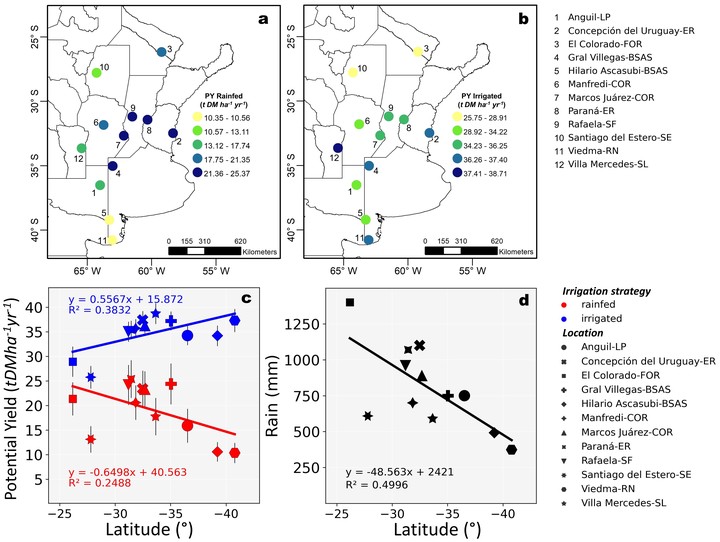
Abstract
Argentina grows the second-largest area of lucerne in the world. Despite its importance, a yield gap exists between potential and measured yields, but factors contributing to it are still unclear. This study aimed to identify management factors and research needs to reduce the lucerne yield gap to improve the livestock systems in this region. We used meteorological data coupled with lucerne crop modelling and measured yields from the National Lucerne Cultivar Evaluation Network (NLCEN) to quantify the lucerne yield gap in nine sites located within the Argentinian Pampas (between parallels 30–45°S and meridians 58–65°W) and three sites outside the Pampas. Specifically, we used the model developed by McCall & Bishop-Hurley (2003), adapted and calibrated for lucerne in Argentina by Berone et al. (2017) to estimate the potential yield (PY) for 12 locations (three irrigated and nine rainfed), and compared those results with measured yields from the NLCEN to calculate yield gaps. We found the average available photosynthetic active radiation (PAR) and temperatures were sufficient to achieve 21.5 ± 3.7 t dry matter (DM) ha−1 yr−1 under rainfed conditions (environments with mean annual rainfall from 400 to 1,200 mm). However, the average measured yield from the NLCEN was 16.8 ± 2.4 t DM ha−1 yr−1 (a 22% gap). Potential yields ranged between 10 and 25 t DM ha−1 yr−1 under rainfed conditions and between 25 and 39 t DM ha−1 yr−1 for irrigated crops. As latitude increased rainfed locations had lower yields, while irrigated locations had higher yields. Adding irrigation was predicted to increase yields to 35.4 ± 2.0 t DM ha−1 yr−1 (a 53% gap) in rainfed sites. For irrigated locations, the gap was smaller (27.3 ± 3.5 vs 32.4 ± 2.2 t DM ha−1 yr−1 for measured vs potential yield, respectively), and most likely linked to nutrient deficits. Also, current grazing management was estimated to achieve approximately 50% less grazing efficiency than optimal grazing management. Our results demonstrated that the livestock industry can potentially increase animal production under current environmental conditions. The four main adjustments to achieve this are increased use of irrigation, increased use of fertilisers, earlier commencement of grazing in spring and increased stocking rates. The costs of irrigation, fertilisers and grazing management are envisaged to be small compared with potential increases in incomes and thus profitability available to beef and dairy farmers using lucerne as a major feed source in Argentina.